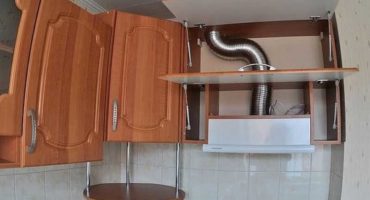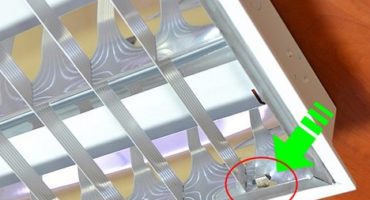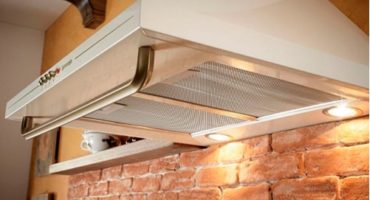Ventilation in the kitchen is provided by a hood, which makes the air fresh and clean. When installing this device, it is important how to install the corrugation on the hood, without spoiling the interior of the kitchen.
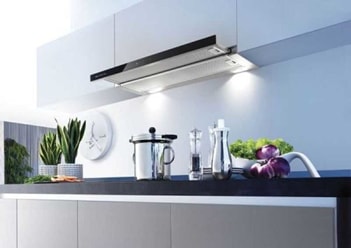
Part of the kitchen interior with hood.
Features of the selection and installation of corrugations under the hood
When buying a hood, we purchase an air duct.
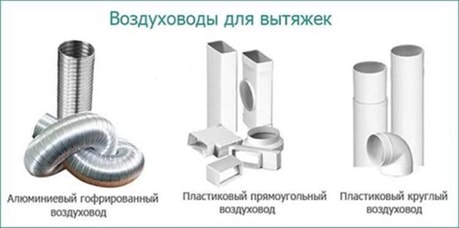
It can be in the form of:
- corrugated aluminum sleeve, which simply takes on the desired shape, due to its flexibility; the disadvantages of the corrugation include noise during operation and inconvenience during washing and cleaning due to the ribbed surface;
- a plastic round duct consisting of convenient polymer pipes; it works "quietly", it is easy to wash, but it is difficult to install;
- square duct made of plastic - PVC, which differs from round only in cross-section.
From the outlet on the hood determine which pipes, with what section fit. During installation, if necessary, you can put the adapter.
Diameter of round air ducts, including corrugated ones: 150mm, 125mm and 100mm. Flat-shaped pipes have different sizes, which can be found in the figure.

Table size of flat PVC pipes.
The diameter of the round pipe or corrugation used for the hood is selected according to the size of its outlet. They must match.
It is not advisable to install an adapter on the outlet for attaching a smaller duct, because of this the air is not cleaned sufficiently, at a low speed.
Plastic and corrugated ducts differ in price, corrugation is cheaper.
Rules and nuances of installation
The ends of the aluminum corrugation are attached to the hood and to the ventilation hole.
For this procedure, you must purchase:
- corrugated pipe, the length of which is selected individually, the selection of diameter is mentioned above;
- clamps made of plastic or metal of the right size corresponding to the diameter of the corrugation;
- special ventilation grill with a hole for the pipe;
- dowels and screws.

Clamp for tightening the ends of the corrugated pipe.
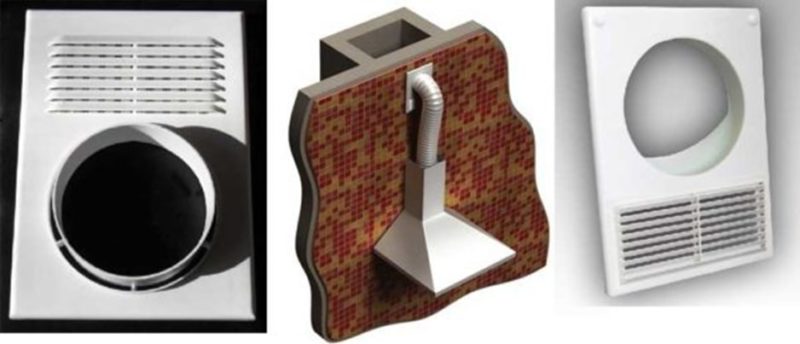
We fix the corrugated pipe to the wall.
Installation Order:
- Before installation, it is necessary to stretch the corrugation as much as possible along its length, this procedure will reduce the noise level produced by the hood during operation.
- We are preparing a ventilation duct. It is undesirable to use natural ventilation, it can be blocked by a pipe and function poorly. The best option is to bring the duct out into the street, provided that the outer wall is next to the hood. If necessary, break through a separate ventilation hole, the dimensions of which must correspond to the diameter of the corrugation. To give a neat appearance, the hole can be greased at the edges using a cement - sand mortar.
- We attach to the wall (or ceiling) a ventilation grill with a hole using dowels and screws, we seal the entire structure.
- The corrugation is attached to the ventilation hole through the grill, the end of the pipe is put on the sides and fastened with clamps or plastic puffs.
- We find a pipe on the hood, the dimensions of which correspond to the diameter of the corrugation. We attach the end of the pipe to it with the help of clamps, we seal everything.
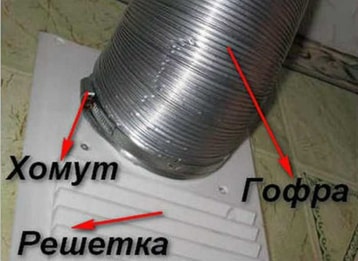
The connection of the pipe to the ventilation grill.
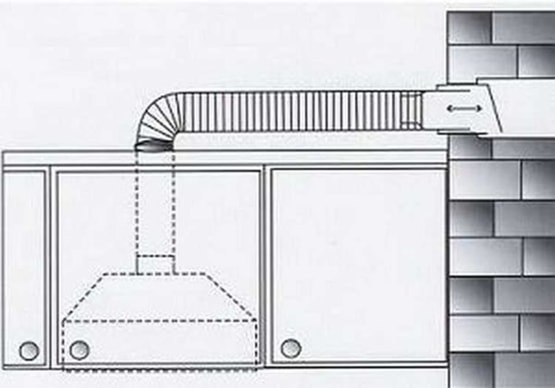
Bringing the duct into the outer wall, the check valve is indicated by an oblique line.
To output the ventilation pipe to the street, you must:
- make a hole in the outer wall;
- insert the corrugation and fix its immobility with cement - sand mortar;
- install an anti-return or check valve to protect against air blown from the street;
- cover the outer hole with a grill to protect it from debris and birds and small animals.
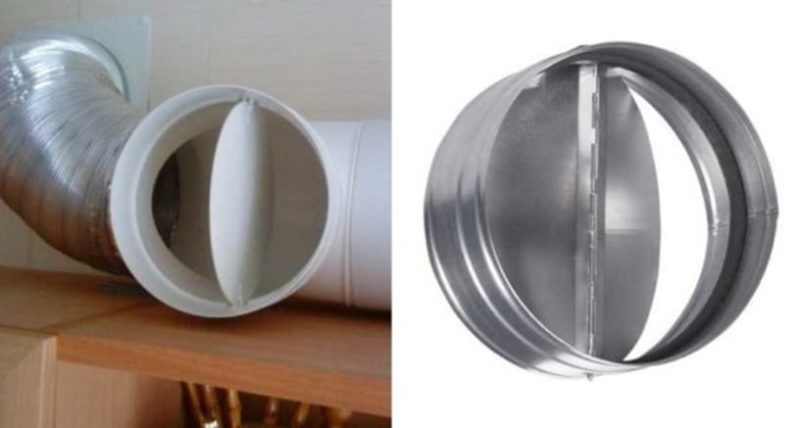
A non-return air valve is a light plate made of plastic or metal.
Using an anti-return valve, street air does not enter the room. It is also installed in the corrugation, connecting the hood with the home ventilation, to prevent odors from pipes from entering the kitchen. When attaching the valve to the pipe in its upper and lower parts, the petals are supported by a small spring. In the non-working state of the hood, the design prevents the penetration of air from the outside. When the ventilation equipment is turned on, the air presses the spring, bending the plate forward. The ventilation system without this valve will create problems for the owner of the room, as odors and cold from the outside will come with air.
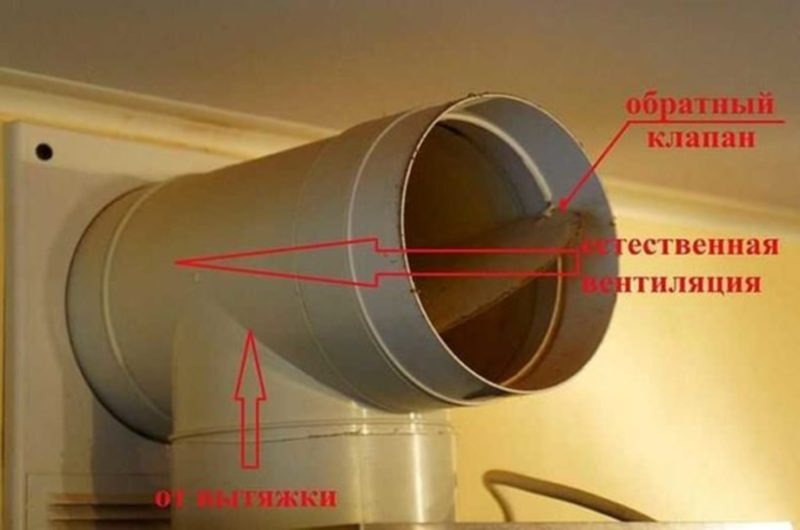
Installed anti-return valve.
Important. If the size of the pipe and the ventilation hole do not match, you can use the adapter.

When using a universal adapter, its excess part is simply cut off.
When installing the corrugation, do not subject it to strong flattening, avoid kinks.
How to hide the corrugation from the hood
Often, bulky corrugation can spoil the interior of the kitchen. It would be better to do without corrugation at all, and install a recirculation type hood that works using filters that trap grease or coal. But this is an expensive option, therefore, let's pay attention to other ways to hide the not-so-beautiful corrugated pipe.
To disguise it, use the following options:
- Decorating with plasterboard box creating a two-level ceiling.
- Close the plastic box, which are sold as decorative elements of various shapes and colors with fixtures. The use of a plastic box is possible provided that the hood is located near the exhaust duct and the absence of a large number of right angles. Failure to comply with these conditions will result in poor airflow.
- Hide the pipe inside the built-in cabinet, which can be placed directly above the stove to the ceiling or in several cabinets throughout the entire length of the corrugation.
- Decorate the pipe with decorative elements, turning the design into an interior detail. You can attract designers for this purpose. And you can just paint the corrugation to match the walls of the kitchen.
- Close the pipe with a hinged ceiling in which local lighting is placed. And the light and the pipe is not visible.
Important. The question of the suspended ceiling is best discussed with specialists. They will help you choose the option of ceiling covering and the size of the ceiling steps in which it is possible to cover the corrugation.

Corrugated pipe hidden in a hanging cabinet.
To install the pipe in a hanging cabinet, you must:
- remove the cabinet;
- mark the places for holes on the shelves;
- we cut out with a jigsaw and glue the edges of the holes with a furniture profile; Flexible profiles are simply bent at the desired angle, while the rigid ones are heated with a construction hairdryer; the profile sits on the "liquid nails";
- place the shelves in a cabinet, which we fix in a constant place;
- through the holes with screws we fix the corrugation.
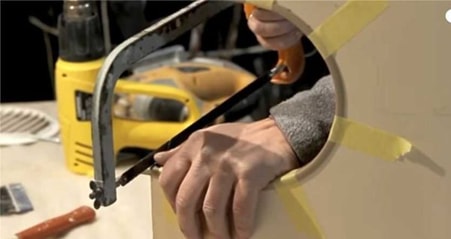
Sawing holes for the corrugation.
When buying a hood, pay attention to the ventilation kits, where the equipment is offered with a corrugated sleeve already attached.
Installation of such kits is not complicated, and masking of pipes is not necessary. All equipment is made in one style and color, which makes it an adornment of the kitchen interior.

